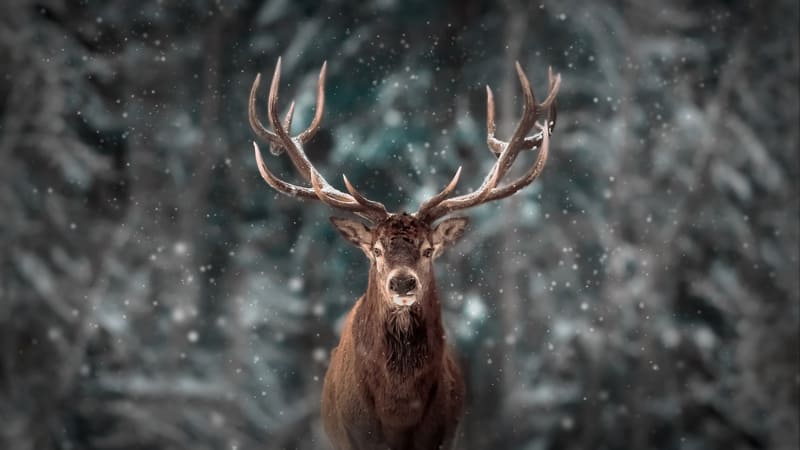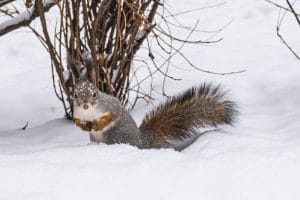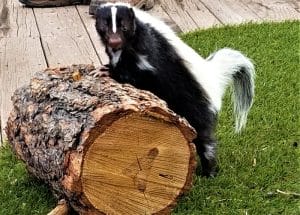When you think of the Christmas season, a few beloved animals come to mind: Rudolph the Red-Nosed Reindeer, the camels that conveyed the three wise men, and of course the partridge in the pear tree! Although these are North American stories and traditions, animals have actually played a key role in Christmas celebrations across the world!
In this holiday blog, the team at Bad Company Wildlife Eviction takes a closer look at the ‘12 animals of Christmas’ and their different Yuletide roles. (P.S. Although we can do a holiday wildlife eviction if you need it, chances are you won’t find these animals in or around your home!)
Reindeer (Hello Rudolph!)
Reindeer are large deer that inhabit cold northern regions. Despite being the same species, reindeer in North America are called caribou. In Canada, caribou have the distinction of making the longest migration of any land animal: during a single year, they can travel as far as 3,000 miles / 5,000 kilometers.
Reindeer have been a Yuletide tradition since the early 19th century. According to the beloved Christmas legend, Rudolph the red-nosed reindeer pulls Santa Claus’s sleigh with a team of nine other reindeer. The TV classic Rudolph the Red-Nosed Reindeer has been watched by millions of families since it made its debut in 1964, making the reindeer one of the most iconic animals of Christmas.
Donkeys: Holiday Transportation!
Donkeys, which belong to the horse family Equidae, are a domesticated subspecies of African wild asses, which can be found in deserts and dry areas of eastern Africa. They were initially domesticated over 3,000 years ago and are still used as pack animals in different parts of the world. Donkeys are an important part of Christmas tradition because Mary rode a donkey while traveling to Bethlehem with Joseph, and they feature prominently in both commercial and private manger scenes, so they definitely belong on this list of the animals of Christmas.
Camels: Ubers for Wise Men
Three species of camel exist: dromedaries, double-humped Bactrians, and wild Bactrians. They are members of the mammal family Camelida, which includes alpacas and llamas. The dromedary and the Bactrian camel are both domesticated and used as pack animals. Wild Bactrian camels are found in Asia, where they are regarded as critically endangered. They are considered one of the animals of Christmas because the Magi, or Three Wise Men, traveled on camels to Bethlehem, and nativity scenes often feature these animals.
European Robin: Representing Christmas Across the Ocean!
In the British Isles, the robin is a popular symbol of Christmas. This small bird, which has a bright red breast, is a common sight in woods and gardens in the British Isles and throughout much of Europe; its regular presence in December gardens has resulted in a strong association with Christmas. Even North American Christmas cards often feature the robin, especially if they have a wildlife theme.
Turkeys: on Every Holiday Table
In most English-speaking countries, turkeys are part of the traditional Christmas feast. Only domesticated turkeys are farmed for food; the wild ones native to North Africa look a lot fiercer and are actually the region’s largest game bird. Although big, wild turkeys are fast and powerful flyers.
Partridge (in a Pear Tree)
The partridge belongs to the bird family Phasianidae, which also includes game birds like chickens, turkeys, and pheasants. Although the gray partridge has been introduced to North America, partridges in general are an Old World species of bird. They are associated with Christmas because a partridge in a pear tree is one of the gifts offered in the popular English carol ‘The Twelve Days of Christmas.’
Turtle Doves: Another Gift During the 12 Days of Christmas
Like the ‘partridge in a pear tree,’ the turtle dove is also mentioned in the Christmas song ‘The Twelve Days of Christmas’. Turtle doves are members of the family Columbidae, which also includes pigeons and doves. They are a pink-hued grey in colour, with pink eye rings and black and white patterning on the neck. Turtle doves spend the winter in southern Africa, so it is unlikely that they will be seen in Europe at Christmas, but the song has forever linked them with the holiday season, making them one of the animals of Christmas.
Wrens: They Have a Day Named After Them!
The Eurasian wren is a brown and grey bird belonging to the Troglodytidae family. It plays such an important role in the traditional Christmas celebrations of Ireland, Wales, the Isle of Man, and other European countries that the day following Christmas is known as ‘Wren Day’ instead of ‘Boxing Day’ in some regions.
Sheep: In Every Nativity Scene
Sheep are mammals in the subfamily Caprinae, which also includes goats. They are also bovids (hoofed animals) with complex digestive systems that allow them to consume plants that are difficult for other animals to digest. Sheep can break down tougher greenery by regurgitating their food and chewing it for a second time as ‘cud.’ They are associated with the holiday season because Christian tradition tells the story of angels announcing the birth of Jesus to shepherds tending their flocks. This is why nativity scenes traditionally include sheep.
Goats: a Northern Yuletide Tradition
Like sheep, goats are members of the Caprinae subfamily. Domesticated goats are a subspecies of Asian wild goats, which include the ibex and other species of so-called ‘mountain monarchs.’
Scandinavians and others in northern Europe celebrate Christmas with the Yule Goat. If you visit these countries, you’ll find Yule goat ornaments under the Christmas tree, and a town’s decorations may include larger straw Yule goats, making them one of Europe’s most beloved animals of Christmas.
Penguins: Cool Christmas Birds!
Penguins are flightless birds that live primarily in the cold, southerly regions of the Southern Hemisphere. (In the Northern Hemisphere, you’ll find only one species of penguin, the Galapagos penguin.) Although clumsy when walking, penguins are fantastic swimmers that ‘fly’ through the water instead of flying in the air.
Because penguins live in cold climates, they are associated with Christmas: holiday cards often feature them alongside polar bears, reindeer, and other cold-weather animals, even though most of them are actually from different regions!.
Polar Bears: on Christmas Cards Everywhere!
Polar bears belong to the bear family Ursidae. Mostly found in the Arctic Circle, these majestic animals have adapted to live in this cold, unwelcoming climate. The thick white coat of the polar bear helps it camouflage itself against icebergs and snow drifts, making it easier for them to hunt while the protective layer of fat underneath helps them preserve body heat. Although polar bears aren’t traditionally associated with Christmas, they often appear on Christmas cards because they live in snowy climates.
We Offer Holiday Wildlife Eviction- But Not For the Animals of Christmas!
We hope you’ve enjoyed this article and its insights into the history behind the 12 animals most commonly associated with Christmas. Although we hope that your holidays will be hassle-free, animals like birds, racoons, and rats don’t always give you ‘time off’ when they’re looking for a new home. If you get animals moving into your home and other places where they don’t belong, Bad Company Wildlife Eviction is here to help. To learn more, call 1-855-880-9860.



